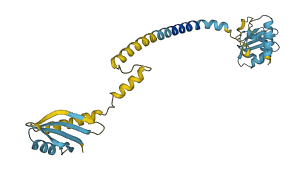Descriptions
The autoinhibited protein was predicted that may have potential autoinhibitory elements via cis-regPred.
Autoinhibitory domains (AIDs)
Target domain |
|
Relief mechanism |
|
Assay |
cis-regPred |
Accessory elements
No accessory elements
Autoinhibited structure

Activated structure

1 structures for Q46833
| Entry ID | Method | Resolution | Chain | Position | Source |
|---|---|---|---|---|---|
| AF-Q46833-F1 | Predicted | AlphaFoldDB |
No variants for Q46833
| Variant ID(s) | Position | Change | Description | Diseaes Association | Provenance |
|---|---|---|---|---|---|
| No variants for Q46833 | |||||
No associated diseases with Q46833
1 regional properties for Q46833
| Type | Name | Position | InterPro Accession |
|---|---|---|---|
| domain | GspL periplasmic domain | 128 - 285 | IPR025691 |
4 GO annotations of cellular component
| Name | Definition |
|---|---|
| Gram-negative-bacterium-type cell wall | The peptidoglycan layer of the Gram-negative cell envelope. In Gram-negative cells the peptidoglycan is relatively thin (1-2nm) and is linked to the outer membrane by lipoproteins. In Gram-negative cells the peptidoglycan is too thin to retain the primary stain in the Gram staining procedure and therefore cells appear red after Gram stain. |
| integral component of membrane | The component of a membrane consisting of the gene products and protein complexes having at least some part of their peptide sequence embedded in the hydrophobic region of the membrane. |
| plasma membrane | The membrane surrounding a cell that separates the cell from its external environment. It consists of a phospholipid bilayer and associated proteins. |
| type II protein secretion system complex | A large protein complex, containing 12-15 subunits, that spans the cell envelope of Gram-negative bacteria and mediates the movement of proteins into the extracellular environment. The complex includes a component in the cytoplasm, an inner membrane subcomplex that reaches into the periplasmic compartment and a secretion pore in the outer membrane. Proteins using the Type II pathway are transported across the cytoplasmic membrane by the Sec or Tat complex. |
No GO annotations of molecular function
| Name | Definition |
|---|---|
| No GO annotations for molecular function |
1 GO annotations of biological process
| Name | Definition |
|---|---|
| protein secretion by the type II secretion system | The process in which proteins are secreted across the outer membrane of Gram-negative bacteria by the type II secretion system. Proteins using this pathway are first translocated across the cytoplasmic membrane via the Sec or Tat pathways. |
No homologous proteins in AiPD
| UniProt AC | Gene Name | Protein Name | Species | Evidence Code |
|---|---|---|---|---|
| No homologous proteins | ||||
| 10 | 20 | 30 | 40 | 50 | 60 |
| MIHQQHMRNI | AQWLQENGIT | RATVAPDWMS | IPCGFMACDA | QRVICRIDEC | RGWSAGLALA |
| 70 | 80 | 90 | 100 | 110 | 120 |
| PVMFRAQLNE | QDLPLSLTVV | GIAPEKLSAW | AGADAERLTV | TALPAITTYG | EPEGNLLTGP |
| 130 | 140 | 150 | 160 | 170 | 180 |
| WQPRVSYRKQ | WARWRVMILP | ILLILVALAV | ERGVTLWSVS | EQVAQSRTQA | EEQFLTLFPE |
| 190 | 200 | 210 | 220 | 230 | 240 |
| QKRIVNLRSQ | VTMALKKYRP | QADDTRLLAE | LSAIASTLKS | ASLSDIEMRG | FTFDQKRQIL |
| 250 | 260 | 270 | 280 | ||
| HLQLRAANFA | SFDKLRSVLA | TDYVVQQDAL | QKEGDAVSGG | VTLRRK |
